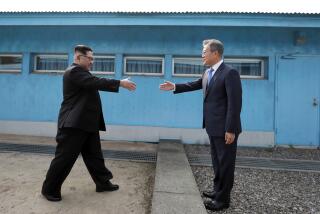Book Review : Korea: The Other ‘Unwinnable’ Conflict
The Bloody Road to Panmunjom by Edwin P. Hoyt (Stein & Day: $18.95)
Now that Americans are, at long last, coming to grips with the Vietnam experience, it seems natural that there should also be a movement to re-examine that earlier “unwinnable” conflict, Korea. Until now, Korea has generally been covered in works on the Cold War, or in a small number of official military accounts. It was not considered promising ground for exciting history. This seems understandable in several respects. On a psychological level, people felt (and still feel) uncomfortable with the war’s failure to resolve the basic conflict between the two Koreas. Militarily, it was America’s World War I: After an initial flurry of movement, both sides settled into a sanguinary stalemate whose goal was not victory but advantage at the negotiating table.
“The Bloody Road to Panmunjom,” by veteran military historian Edwin Hoyt is the third work of a trilogy on the American military role in Korea. The first two books, “The Pusan Perimeter: Korea, 1950” and “On to the Yalu,” deal with the early period of the war from June to November, 1950, when, after the stubborn defense of southeastern Korea and the “miracle at Inchon,” U.N. forces had conquered nearly all of Korea and were in sight of the Chinese border and, unknown to them, disaster. It is the progress of this disaster and its denouement at the Panmunjom conference table that forms the substance of Hoyt’s latest effort.
Repeated Warnings
Despite repeated warnings that the Chinese would intervene if the U.N. forces closed in on the Manchurian border, Gen. Douglas MacArthur, having “recovered his ego . . . made plans in the second week of November for business as usual--the advance to the Yalu would continue.” Ever since the middle of October, however, the Chinese had infiltrated some 300,000 “volunteers” into North Korea. As the U.N. troops drew near, the Chinese attacked. To the accompaniment of crashing cymbals, loudspeakers and blaring bugles, they drove the U.N. forces back below the 38th Parallel, although suffering “a cost no American commander would liked to have paid.” President Harry S. Truman replaced a chagrined MacArthur with Gen. Matthew B. Ridgway and a strategy of attrition set in on both sides for the remainder of the war. Offensives and counteroffensives seesawed back and forth across the 38th Parallel as both sides jockeyed for position during the two years of negotiations that finally yielded the armistice of July 27, 1953.
“The Bloody Road to Panmunjom” is first and last a history of U.N.--and, overwhelmingly, U.S.--combat troops. Hoyt’s stated purpose is to honor “the thousands of heroes” the war created who have remained “little known to Americans because they do not like to read about wars that have not been won.” Culled largely from official military histories, most of the book belongs to that subgenre of battle narrative that is the province of buffs: exhaustive litanies of names, units and locations that bog the reader down as one engagement follows another.
Reward for Patient Layman
Yet, there are kernels of good spare writing that occasionally reward the patient layman. Hoyt’s examination of the changes in U.S. strategy after the MacArthur dismissal and his description of Chinese fraternization attempts with American Marines after the armistice add some badly needed flesh to the book.
Hoyt’s conclusions as to the war’s significance, though simplistic and, in the context of the ‘80s, hardly original, are nevertheless worth noting: “. . . The Korean War was not a failure, but a success, in the end . . . for the first and only time in history, men of many nations banded together in the common cause of preventing an aggressive force from having its own way in world politics.” While far from a definitive “total history” of the war, “The Bloody Road to Panmunjom” is a modest success within its own circumscribed sphere. In a larger context, it signifies the extent of the change in the assessment of the American role in Korea.


